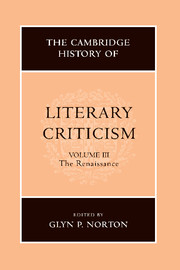Book contents
- Frontmatter
- Introduction
- READING AND INTERPRETATION: AN EMERGING DISCOURSE OF POETICS
- POETICS
- THEORIES OF PROSE FICTION
- CONTEXTS OF CRITICISM: METROPOLITAN CULTURE AND SOCIO-LITERARY ENVIRONMENTS
- VOICES OF DISSENT
- STRUCTURES OF THOUGHT
- 45 Renaissance Neoplatonism
- 46 Cosmography and poetics
- 47 Natural philosophy and the ‘new science’
- 48 Stoicism and Epicureanism: philosophical revival and literary repercussions
- 49 Calvinism and post-Tridentine developments
- 50 Port-Royal and Jansenism
- NEOCLASSICAL ISSUES: BEAUTY, JUDGEMENT, PERSUASION, POLEMICS
- A SURVEY OF NATIONAL DEVELOPMENTS
- Bibliography
- Index
- References
46 - Cosmography and poetics
from STRUCTURES OF THOUGHT
Published online by Cambridge University Press: 28 March 2008
- Frontmatter
- Introduction
- READING AND INTERPRETATION: AN EMERGING DISCOURSE OF POETICS
- POETICS
- THEORIES OF PROSE FICTION
- CONTEXTS OF CRITICISM: METROPOLITAN CULTURE AND SOCIO-LITERARY ENVIRONMENTS
- VOICES OF DISSENT
- STRUCTURES OF THOUGHT
- 45 Renaissance Neoplatonism
- 46 Cosmography and poetics
- 47 Natural philosophy and the ‘new science’
- 48 Stoicism and Epicureanism: philosophical revival and literary repercussions
- 49 Calvinism and post-Tridentine developments
- 50 Port-Royal and Jansenism
- NEOCLASSICAL ISSUES: BEAUTY, JUDGEMENT, PERSUASION, POLEMICS
- A SURVEY OF NATIONAL DEVELOPMENTS
- Bibliography
- Index
- References
Summary
Cosmography or the description of the constitution of the world, comprising astronomy as well as geography, is related to poetics either by analogy (poems being taken as metaphors of the cosmos, the object of cosmography) or by exposition (in poetry aiming partially or totally at practising the writing of cosmography). Both relations will be considered here, as well as some effects of the scientific revolution on them. Since it is, of course, impossible to be exhaustive, only some of the most representative texts will be mentioned and broad characteristics will be highlighted, rather than specific differences.
The analogy between cosmos and logos, establishing unity and harmonious variety as the basic rules of classical rhetoric and poetics, is already present in Plato. Augustine develops this analogy in a variety of influential texts. Among the other ancient sources, Macrobius, who stressed the similarity between Virgil's poetry and God's Creation (Saturnales V.1.19–20), is one of the most important. In the early Renaissance, the theme reappears in many prescriptions for artistic variety, also inspired by the Byzantine tradition following Hermogenes and ‘imported’ into Italy by George of Trebizond. Angelo Poliziano, for example, developed in detail the Macrobian comparison between Virgil's work and God's Creation in his ‘Manto’ (1482, lines 351–67), where the vivid descriptions of the poet's text are said to mirror the most ‘variegated species’ [discors facies] of the beauty of the world. Many Renaissance authors claimed a similar beauty for their works. The theme of poetry as an analogue of the world because of Its ‘energetic’ descriptions and the Concordia discors of their variety is repeated by Vida (De arte poetica, III.64–75), Ronsard (‘Elégie à Des Masures’, 1–13), Vauquelin de La Fresnaye (Art poétique, III.659–75), Tasso (Discorsi del poema eroico), and others.
- Type
- Chapter
- Information
- The Cambridge History of Literary Criticism , pp. 442 - 448Publisher: Cambridge University PressPrint publication year: 1999
References
- 2
- Cited by



